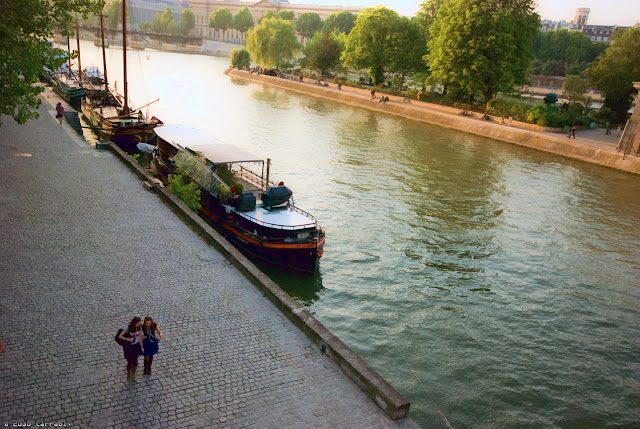 |
| The Pont des Arts or Passerelle des Arts is a pedestrian bridge in Paris which crosses the Seine River. It links the Institut de France and the central square (cour carrée) of the palais du Louvre, (which had been termed the "Palais des Arts" under the First Empire). Between 1802 and 1804, a nine-arch metallic bridge for pedestrians was constructed at the location of the present day Pont des Arts: this was the first metal bridge in Paris. This innovation was due to Napoléon I, following a design of English manufacture. The engineers Louis-Alexandre de Cessart and Jacques Dillon initially conceived of a bridge which would resemble a suspended garden, with trees, banks of flowers, and benches. In 1976, the Inspector of Bridges and Causeways (Ponts et Chaussées) reported several deficiencies on the bridge. More specifically, he noted the damage that had been caused by two aerial bombardments sustained during World War I and World War II and the harm done from the multiple collisions caused by boats. The bridge would be closed to circulation in 1977 and, in 1979, suffered a 60 meter collapse after a barge rammed into it. The present bridge was built between 1981 and 1984 "identically" according to the plans of Louis Arretche, who had decided to reduce the number of arches from nine to seven, allowing the look of the old bridge to be preserved while realigning the new structure with the Pont Neuf. On 27 June 1984, the newly reconstructed bridge was inaugurated by Jacques Chirac – then the mayor of Paris. The bridge has sometimes served as a place for art exhibitions, and is today a studio en plein air for painters, artists and photographers who are drawn to its unique point of view. The Pont des Arts is also frequently a spot for picnics during the summer. The argentinian writer, Julio Cortázar, talks about this bridge in his book "Rayuela". When Horacio Oliveira goes with the pythia and this tells him that the bridge for La Maga is the "Ponts des Arts". This is a great allusion of Cortázar for one of his greatest novels, even one of the best novels ever written. |
The Magic of the Cities.
Zen promotes the rediscovery of the obvious, which is so often lost in its familiarity and simplicity. It sees the miraculous in the common and magic in our everyday surroundings. When we are not rushed, and our minds are unclouded by conceptualizations, a veil will sometimes drop, introducing the viewer to a world unseen since childhood. ~ John Greer
Showing posts with label Pont des Arts. Show all posts
Showing posts with label Pont des Arts. Show all posts
Monday, August 2, 2010
Pont des Arts
Tuesday, July 20, 2010
The Seine I
 |
“Under a blazing mid-afternoon summer sky, we see the Seine flooded with sunshine . . . people are strolling, others are sitting or stretched out lazily on the bluish grass.” Georges Seurat. |
The waters of the River Seine have always been the heart and soul of Paris, dating back to the days when the Parisii tribe first established a fishing village on the island now known as Île de la Cité — between 250 and 200 B.C. Prized for its position as a major inland port, Paris has been invaded, occupied, and conquered by its share of foreigners over the course of two millennia, many of whom arrived by this waterway. The last major invasion by water occurred between 885 and 886 A.D., when 30,000 Norman pirates in 700 ships sailed up the Seine, only to find it valiantly defended by Comte Eudes.
Ever since the days of the Roman Empire, when Paris prospered through extensive river trading and expanded to the Left Bank, the Seine has been a great commercial artery, linked by canals to the Loire, Rhine, and Rhône rivers. Officially established as the capital city by Clovis, king of the Franks (who defeated the Roman governor of Gaul and established the Merovingian dynasty), Paris evolved into a cultural center and a showcase of glorious architecture.
It is appropriate that the center of Paris — particularly that section gracing the Seine around Île de la Cité and Île Saint-Louis — features some of the city's oldest and most majestic historic monuments. (discoverfrance.net)
Subscribe to:
Comments (Atom)









